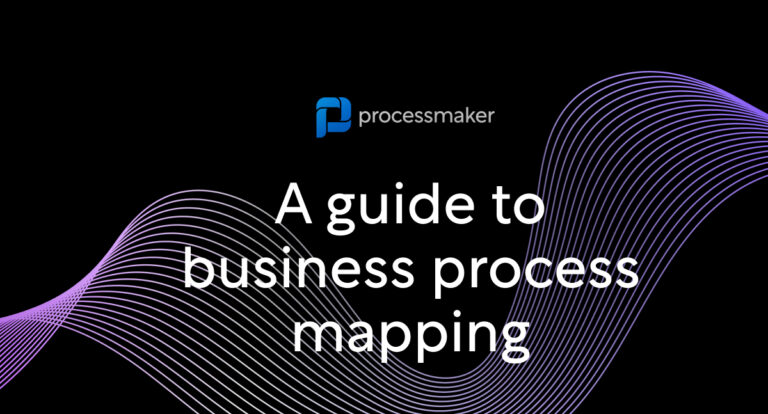Process mapping plays an important role in understanding and improving business processes. For newcomers, the scope of the technique’s application can seem daunting. Let’s break this concept down and look at some examples for common business processes.
Want to make process mapping even easier? Check out our 2023 Summer Release webinar. With the text-to-process feature, you can create a process map in seconds just by describing it with natural language.
You no longer have to worry about a learning curve. The text-to-process feature doesn’t require any tech experience. Enter a new era of hyperautomation, business process automation, and intelligent automation, and transform your workflow and productivity.
Try it yourself with our free trial.
What is Process Mapping?
Process mapping is a management tool that visualizes the flow of work within a business process. A process map shows the steps and people involved in a business process before automating it.
It is important to understand the different roles and functions of process diagrams, process mapping, and process modeling. Creating a process diagram is the first step in creating a business process model. It is a simple representation of a process that merely lists tasks in sequential order.

A process map is the second step in creating a process model. The map includes a higher level of detail, listing things like the employees involved and events. A business process model is a complete visual representation of all aspects of a process.
Types of Process Maps
An important step in process mapping is choosing the type of map that you want to use. There are many to choose from, but you will want to choose one that aligns with your objectives. Some common types of process maps include:
- Flowcharts. Flowcharts are maps that show the steps of a process including its inputs and outputs. There are three types of flowcharts that are widely used. Top-down flowcharts show the steps of a process in a single flow. Deployment flowcharts identify who is performing each task. Detailed flowcharts expand on both and show a much higher level of detail.
- Data Flow Diagram. Like flowcharts but focus on the flow of data through a system.
- Swimlane Diagrams. Swimlane maps, also called cross-functional maps, show who does what. Activities are separated into lanes based on who is responsible for each task. These diagrams are useful for management purposes and workflow automation.
- Value Stream Mapping. These maps show the steps required to deliver a product or service to end users. Value stream mapping is useful for things like identifying waste and planning future projects.
Process Mapping Examples
Service Desk
Many organizations have automated part of their service desk workflows to save money and provide efficient service. Workflows need to route requests to the appropriate parties and provide a means of prioritizing requests with automated tools.
A service desk process starts at the user level with a submission. From there the request proceeds to the next step where it is assessed for immediate resolution or escalation. Once resolved, the user is notified, and the request is finalized and closed out.
Recruiting
Recruiting has traditionally been a time-consuming and tedious HR task. Recruiters are increasingly turning to automation solutions like robotic process automation (RPA) to sort through candidate applications and place them into different categories based on their qualifications.

The first step in a workflow could be when a candidate submits a resume. From there, the RPA solution reviews and scores the candidate and decides whether an interview should be scheduled. The candidate is then notified, an interview is conducted, a decision is made, and an offer is extended.
Procurement
Procurement process workflows can be complex. Manual submissions and approvals can lead to significant delays and a lack of visibility.
A procurement workflow begins when a request is sent to the purchase department. From there the procurement department will investigate vendors, request quotes, and select a vendor. Once the vendor and terms are agreed upon, a purchase requisition for approval is submitted.
If approved, a purchase order is sent to the vendor. The vendor sends an invoice followed by the goods for services. The process is completed when payment is made. If denied, the requestor is provided with a reason.
Customer Onboarding

Providing a good onboarding experience is vital to customer retention. Onboarding processes have grown in complexity due to a greater number of customer touchpoints. This is especially true in highly regulated industries like banking.
Maps of customer onboarding processes will look different depending on the organization and industry. A map of a simple onboarding process may start with an email from a prospective customer. An autoresponder replies with basic information. A representative then follows up to discuss the request in more detail.
If the customer is a good fit, the representative schedules an appointment. Terms are negotiated, the customer signs a contract and leaves a deposit. Required documents are collected, and work begins.
Business Process Mapping Best Practices
When preparing your process map, remember to:
- Keep it simple. The goal of process mapping is to provide visibility and understanding. The map should be easy to follow and understood by anyone in your organization.
- Define your objectives. Write down what you are hoping to achieve. Do you want to improve quality? Reduce costs?
- Aim for good. Process maps do not need to be perfect, only usable.
- Fully map your processes before improving your processes. Understand the ins and outs of your “as-is” process before implementing changes.
How does process mapping generate Hyper-Productivity
Process mapping plays a pivotal role in driving hyper-productivity within organizations. By visually depicting and analyzing workflows, it provides a clear understanding of how tasks and activities are carried out. This transparency allows for the identification of bottlenecks, redundancies, and inefficiencies, which can then be streamlined or eliminated. Process mapping also facilitates standardization, ensuring that best practices are consistently followed. As a result, teams work more cohesively, decision-making becomes more data-driven, and productivity soars.
Process mapping is an effective management tool offered by automation platforms that helps stakeholders understand and improve business processes. Easily create process maps like the above examples for your business processes with ProcessMaker’s low-code business process management (BPM) software.
Chat with our team to learn how process mapping and intelligent process automation can transform how you work and increase efficiency.





